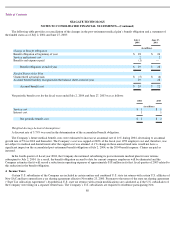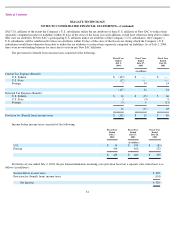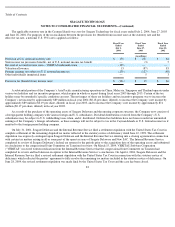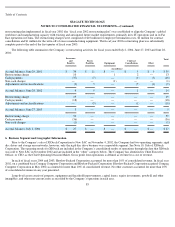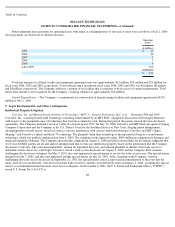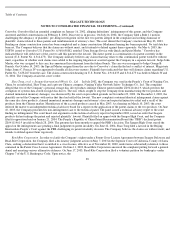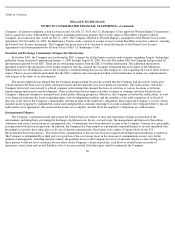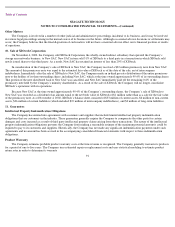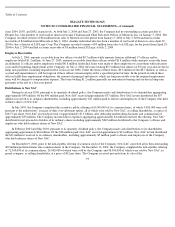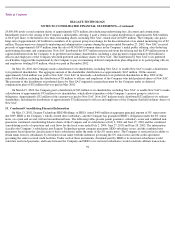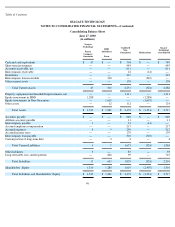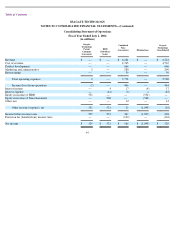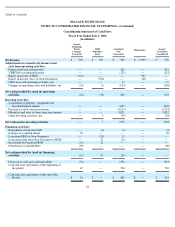Seagate 2003 Annual Report Download - page 90
Download and view the complete annual report
Please find page 90 of the 2003 Seagate annual report below. You can navigate through the pages in the report by either clicking on the pages listed below, or by using the keyword search tool below to find specific information within the annual report.
Table of Contents
SEAGATE TECHNOLOGY
NOTES TO CONSOLIDATED FINANCIAL STATEMENTS—(Continued)
Convolve. Convolve filed an amended complaint on January 16, 2002, alleging defendants’ infringement of this patent, and the Company
answered and filed counterclaims on February 8, 2002. Discovery is in process. On July 26, 2002, the Company filed a Rule 11 motion
challenging the adequacy of plaintiffs’ pre-filing investigation on the first two patents alleged in the complaint and seeking dismissal of
plaintiffs’ claims related to these patents and reimbursement of attorney’s fees. The court denied the Company’s motion on May 23, 2003.
Briefing on claims construction issues has been completed and a claims construction (Markman) hearing has been requested. No trial date has
been set. The Company believes that the claims are without merit, and it intends to defend against them vigorously. On May 6, 2003, the
USPTO issued to Convolve U.S. Patent No. 6,560,658 B2, entitled “Data Storage Device with Quick and Quiet Modes.” Convolve has
indicated that it will seek leave of the court to add this patent to the lawsuit. This latest patent is a continuation of a patent currently in the
lawsuit (U.S. Patent No. 6,314,473). The Company similarly believes any claims that may relate to this continuation patent would be without
merit, regardless of whether such claims were added to the ongoing litigation or asserted against the Company in a separate lawsuit. Judge John
Martin, who was assigned to this case, has announced his retirement from the federal bench. The case was reassigned to Judge George B.
Daniels. On October 14, 2003, the Special Master resigned from the case due to Convolve’s claim that he had a conflict of interest. Magistrate
Judge James C. Francis IV was appointed to handle all discovery matters. Plaintiffs have indicated that they will dismiss claims regarding U.S.
Patent No. 5,638,267 from the case. The claims construction hearing on U.S. Patent Nos. 4,916,635 and 6,314,473 was held on March 30 and
31, 2004. The Company awaits the court’s order.
Shao Tong, et al. v. Seagate International (Wuxi) Co., Ltd . In July 2002, the Company was sued in the People’s Court of Nanjing City,
China, by an individual, Shao Tong, and a private Chinese company, Nanjing Yisike Network Safety Technique Co., Ltd. The complaint
alleged that two of the Company’s personal storage disc drive products infringe Chinese patent number ZL94111461.9, which prevents the
corruption of systems data stored on rigid disc drives. The suit, which sought to stop the Company from manufacturing the two products and
claimed immaterial monetary damages, was dismissed by the court on procedural grounds on November 29, 2002. On December 3, 2002, the
plaintiffs served the Company with notice that they had refiled the lawsuit. The new complaint contained identical infringement claims against
the same disc drive products, claimed immaterial monetary damages and attorney’s fees and requested injunctive relief and a recall of the
products from the Chinese market. Manufacture of the accused products ceased in May 2003. At a hearing on March 10, 2003, the court
referred the matter to an independent technical advisory board for a report on the application of the patent claims to the two products. On June
10, 2003, the Company presented its non-infringement case to the technical panel. The panel issued a technical advisory report to the court
finding no infringement. The court heard oral arguments on the technical advisory report in September 2003, issued an order that Seagate
products did not infringe the patent and rejected plaintiffs’ lawsuit. Plaintiffs filed an appeal with the Jiangsu High Court, and the Company
filed its opposition brief on January 21, 2004. The People’s Republic of China Patent Reexamination Board (the “PRB”) declared patent
ZL94111461.9 invalid on March 28, 2004. The patentee has three months to appeal the PRB’s decision. The Jiangsu High Court stayed the
appeal on the infringement case pending a final judgment on patent invalidity. On June 22, 2004, Shao Tong filed a lawsuit in the Beijing
Intermediate People’
s Court against the PRB challenging its patent invalidity decision. The Company believes the claims are without merit, and
intends to defend against them vigorously.
Read-Rite Corporation . In order to clarify the Company’s rights under a Patent Cross-
License Agreement between Seagate Delaware and
Read-Rite Corporation, the Company filed a declaratory judgment action on May 7, 2003 in the Superior Court of California, County of Santa
Clara, seeking a declaration that it is entitled to a cross-license, effective as of November 22, 2000, under terms substantially identical to those
contained in the Patent Cross License Agreement. On June 11, 2003, Read-Rite Corporation answered the complaint putting forward a general
denial and asserting various affirmative defenses. On June 17, 2003, Read-Rite Corporation filed a voluntary petition for bankruptcy under
Chapter 7 of the U.S. Bankruptcy Code. Upon notice, the
89



